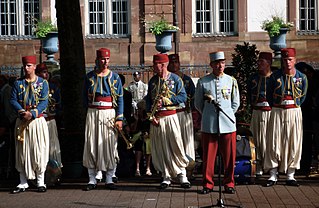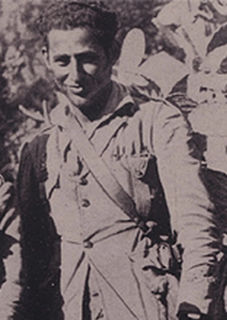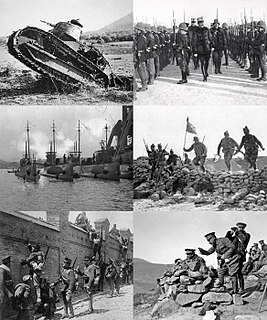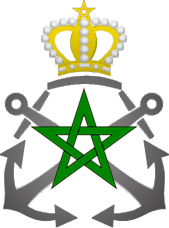
The Foreign Legion is a corps of the French Army with a specific command and comprising several specialities: infantry, cavalry, engineers, airborne troops. It was created in 1831 to allow the incorporation of foreign nationals into the French Army. It formed part of the Armée d’Afrique, the French Army's units associated with Africa, until the end of the Algerian war in 1962.

MoulayYusef ben Hassan, born in Meknes on 1882 and died in Fes on 1927, was the Alaouite sultan of Morocco from 1912 to 1927. He was the son of Hassan ben Mohammed.

The Condor Legion was a unit composed of military personnel from the air force and army of Nazi Germany, which served with the Nationalist faction during the Spanish Civil War of July 1936 to March 1939. The Condor Legion developed methods of strategic bombing that were shortly afterward used widely during the Second World War. The bombing of Guernica was the most infamous operation carried out by the Condor Legion. Hugo Sperrle commanded the unit's aircraft formations and Wilhelm Ritter von Thoma commanded the ground element.

The French protectorate in Morocco, also known as French Morocco, was the French military occupation of a large part of Morocco established in the form of a colonial regime imposed by France while preserving the Moroccan royal regime known as the Sherifian Empire under French rule. The protectorate was officially established 30 March 1912, when Sultan Abd al-Hafid signed the Treaty of Fes, though the French military occupation of Morocco had begun with the invasion of Oujda and the bombardment of Casablanca in 1907.

For centuries, Spain recruited foreign soldiers to its army, forming the Foreign Regiments - such as the Regiment of Hibernia(formed in 1709 from Irishmen who fled their own country in the wake of the Flight of the Earls and the penal laws). However, the specific unit of the Spanish Army and Spain's Rapid Reaction Force, now known as the Spanish Legion, and informally known as the Tercio or the Tercios, is a 20th-century creation. It was raised in the 1920s to serve as part of Spain's Army of Africa. The unit, which was established in January 1920 as the Spanish equivalent of the French Foreign Legion, was initially known as the Tercio de Extranjeros, the name under which it began fighting in the Rif War of 1920–1926. Although foreign recruitment spans the Spanish-speaking nations, the majority of recruits are Spaniards. Over the years, the force's name has changed from Tercio de Extranjeros to Tercio de Marruecos, and by the end of the Rif War it became the "Spanish Legion", with several "tercios" as sub-units.

The Ifni War, sometimes called the Forgotten War in Spain, was a series of armed incursions into Spanish West Africa by Moroccan insurgents that began in October 1957 and culminated with the abortive siege of Sidi Ifni.
The Army of Africa or Moroccan Army Corps was a field army of the Spanish Army that garrisoned the Spanish protectorate in Morocco from the late 19th century until Morocco's independence in 1956.

Muhammad Sidi Brahim Sidi Embarek Basir was a Sahrawi nationalist leader, disappeared and presumedly executed by the Spanish Legion in June 1970.

A tirailleur, in the Napoleonic era, was a type of light infantry trained to skirmish ahead of the main columns. Subsequently tirailleurs was used by the French Army as a designation for indigenous infantry recruited in the French colonial territories during the 19th and 20th centuries, or for metropolitan units serving in a light infantry role.

Collins Barracks is a military barracks on the Old Youghal Road on the north side of Cork in Ireland. Originally serving as a British military barracks from the early 19th century, it was handed-over to the Irish military following the Irish War of Independence, and remains the headquarters of the 1st Brigade of the Irish Army. A museum in the barracks is open to the public at selected times.

Mohammed ben Mizzian was a Moroccan marshal from Beni Ansar.

The Fuerzas Regulares Indígenas, known simply as the Regulares (Regulars), are volunteer infantry units of the Spanish Army, largely recruited in the cities of Ceuta and Melilla. Consisting of indigenous infantry and cavalry recruited in Spanish Morocco, forming part of the Army of Africa and officered by Spaniards, these troops played a significant role in the Spanish Civil War (1936–1939).

The siege of Madrid was a two and a half year siege of the Republican controlled Spanish capital city of Madrid by the Nationalist armies under General Francisco Franco, during the Spanish Civil War of 1936 to 1939. The city, besieged from October 1936, fell to the Nationalist armies on 28 March 1939. The Battle of Madrid in November 1936 saw the most intense fighting in and around the city when the Nationalists made their most determined attempt to take the Republican capital.

The Rif War was an armed conflict fought from 1921 to 1926 between the occupying colonialists of Spain and the Berber tribes of the mountainous Rif region of northern Morocco.

The Royal Navy of Morocco is a branch of the military of Morocco responsible for conducting naval operations. The Royal Moroccan Navy is administratively managed by the Administration of Defence, which is commanded by King Mohammed VI, the commander-in-chief of the Moroccan Armed Forces.
The military history of Morocco covers a vast time period and complex events. It interacts with multiple military events in a vast area containing North Africa and the Iberian peninsula.

The National Roman Legion Museum is a museum in Caerleon, near Newport, south-east Wales. It is one of three Roman sites in Caerleon, along with the Baths museum and the open-air ruins of the amphitheatre and barracks. It is part of the wider network of Amgueddfa Cymru – National Museum Wales.

The French conquest of Morocco began in 1907 and continued until 1934. By the Treaty of Fez of 1912, France gained a protectorate over Morocco and spent the next two decades taking control of the country.

The July 1936 military uprising in Melilla occurred at the start of the Spanish Civil War. The rebels seized the main garrisons of the Spanish Army in Africa and by 18 July had crushed the resistance of the army officers loyal to the Republican government. The supporters of the Second Spanish Republic were detained or shot.
The Battle of Albarracín took place in Albarracín and surrounding areas (Teruel) between 5 July and 11 August 1937, during the Spanish Civil War.



















